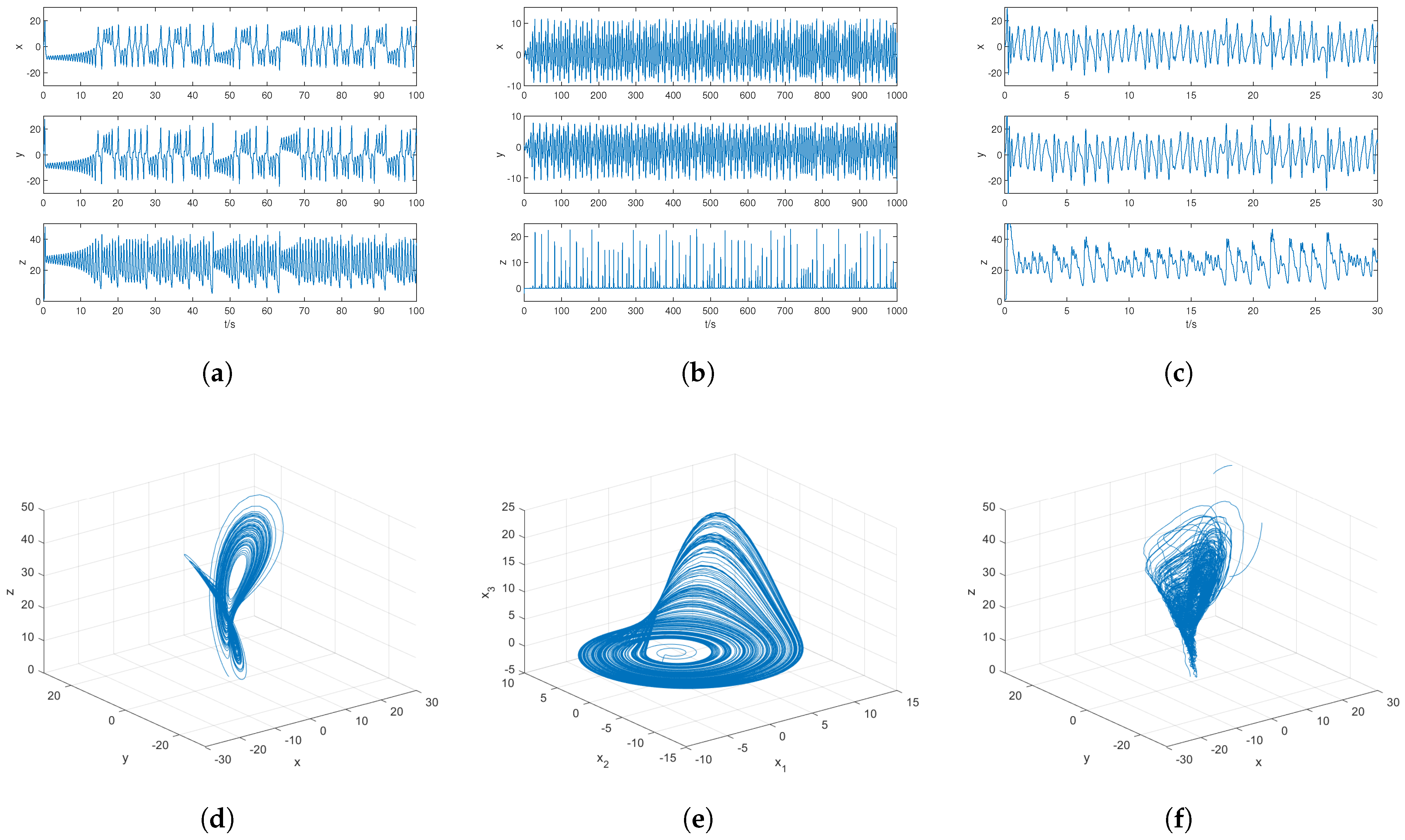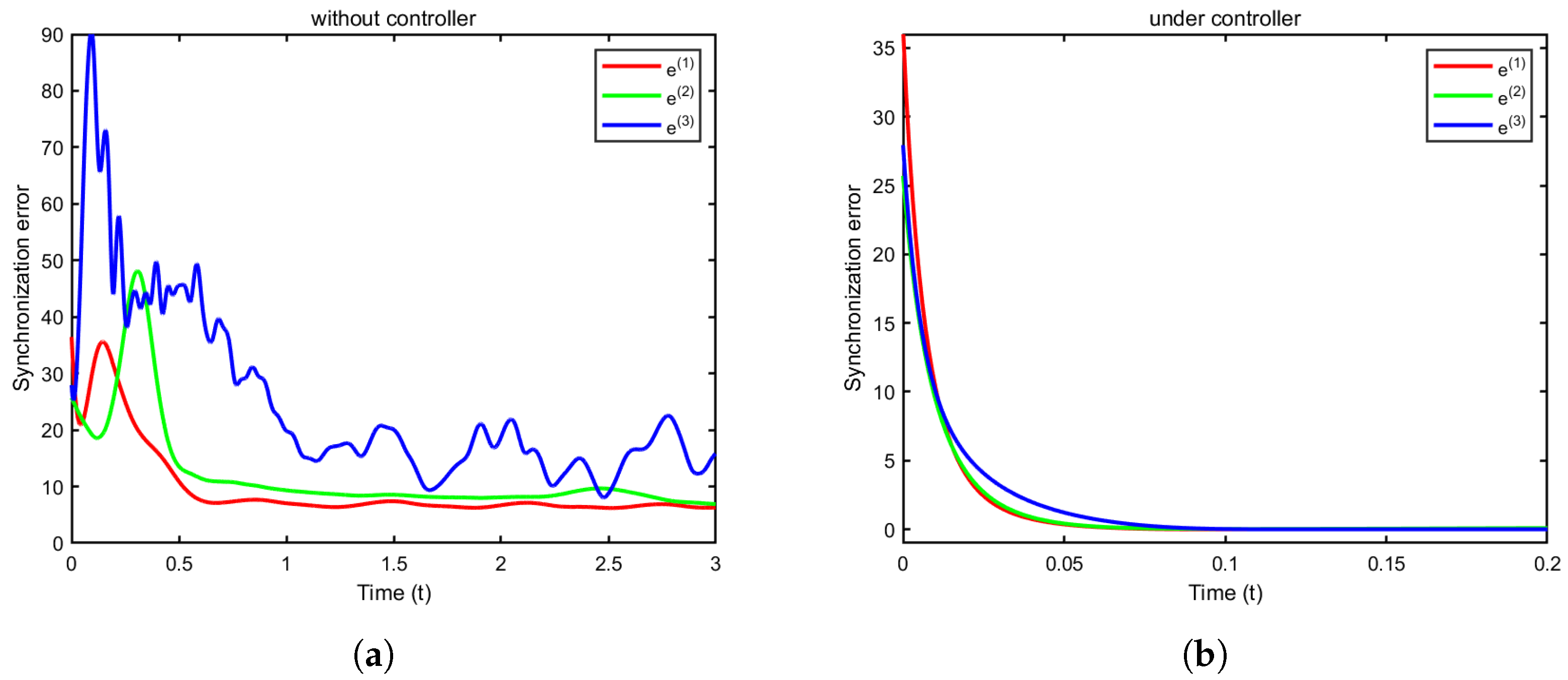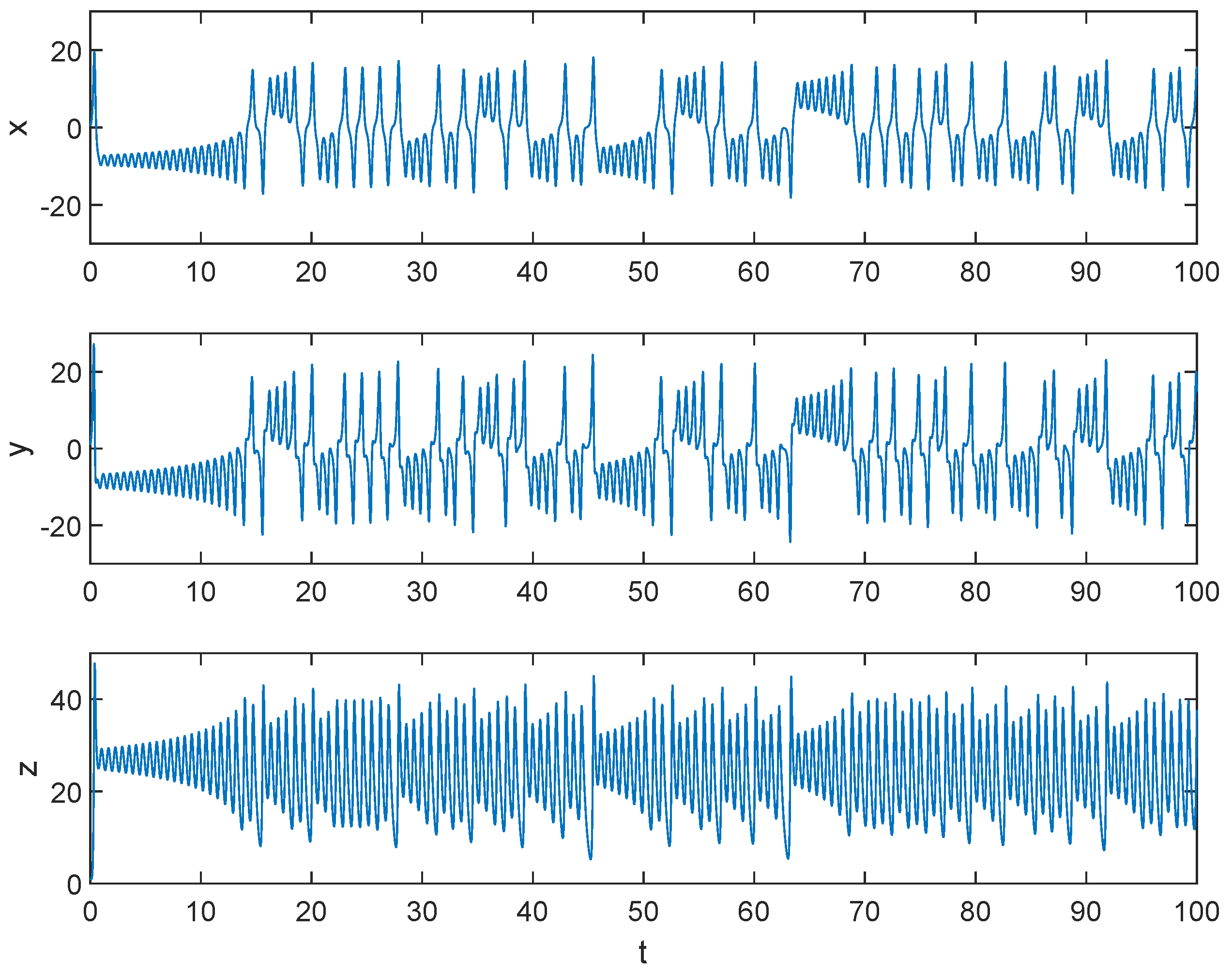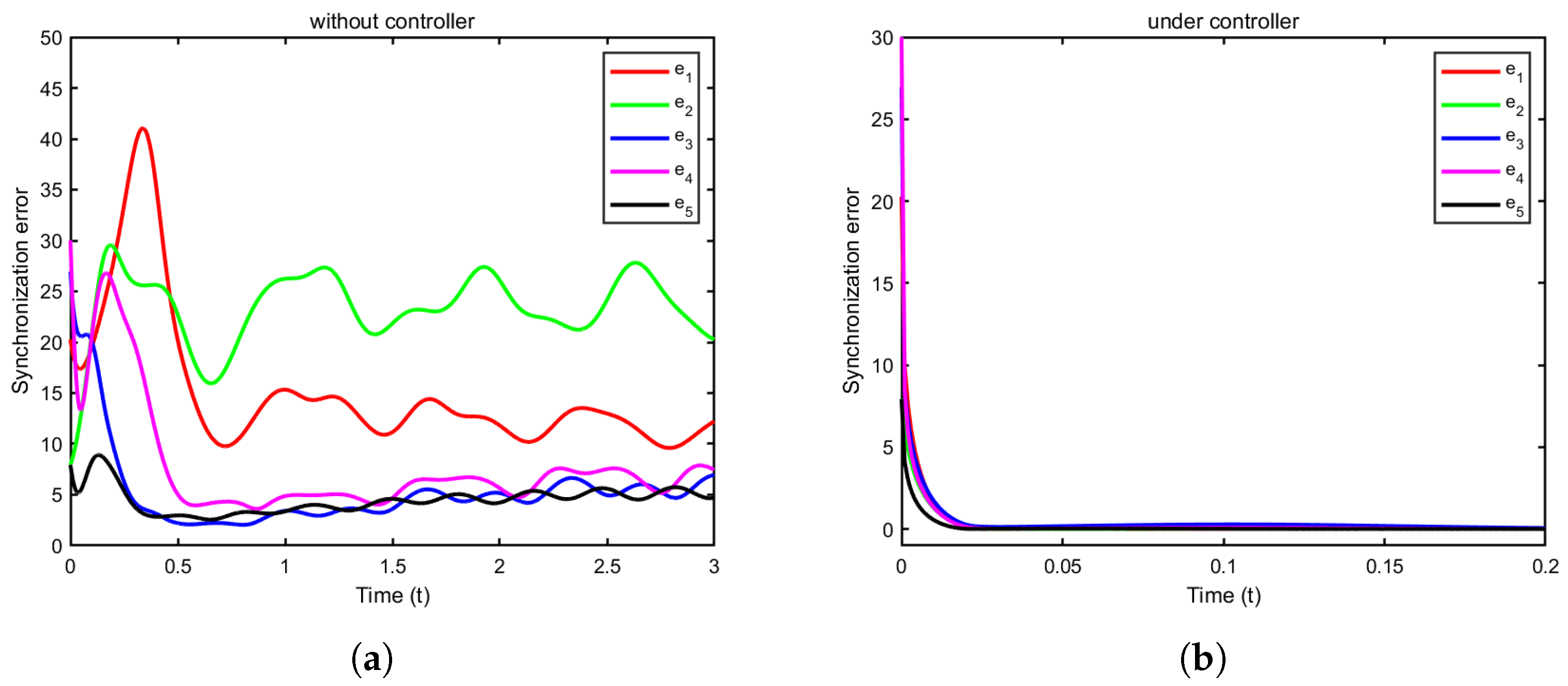Fast Fixed-Time Control for Intra- and Inter-Layer Synchronization of Multi-Layer Networks
Abstract
1. Introduction
- (1)
- Generalized MLN framework: Extending beyond conventional bi-layer models, we develop a multi-layer architecture supporting arbitrary layers and heterogeneous intra-layer topologies, enabling mesoscale synchronization analysis in complex hierarchical systems.
- (2)
- FDTS implementation: We propose a series of innovative sufficient conditions from both theoretical and numerical perspectives, ensuring that MLNs achieve intra-layer and inter-layer synchronization within a fixed time regardless of initial conditions. Furthermore, the developed controller demonstrates faster convergence rates compared to existing approaches [31].
- (3)
- Accelerated convergence validation: Under the guidance of FDTS strategy, this study effectively realizes intra-layer and inter-layer synchronization in MLNs. By rigorously applying Lyapunov stability theory, we derive precise synchronization criteria for multi-layer architectures. Additionally, systematic numerical simulations validate both the theoretical validity and practical applicability of the proposed methodology.
2. Preliminaries
3. Intra-Layer and Inter-Layer Synchronization of MLNs by FDTS Method
3.1. Intra-Layer Synchronization
3.2. Inter-Layer Synchronization
4. Simulation Example
4.1. Intra-Layer Synchronization
4.2. Inter-Layer Synchronization
5. Conclusions
Author Contributions
Funding
Data Availability Statement
Conflicts of Interest
References
- Sheng, Y.; Xing, Y.; Huang, T.; Zeng, Z. Global exponential synchronization of delayed fuzzy neural networks with reaction diffusions. IEEE Trans. Fuzzy Syst. 2023, 31, 2809–2820. [Google Scholar] [CrossRef]
- Zheng, Z.; Zhang, Q. Synchronization in directed nonlinear complex networks under intermittent stochastic control. Commun. Nonlinear Sci. Numer. Simul. 2024, 132, 107894. [Google Scholar] [CrossRef]
- Liu, J.; Sun, J.P. Pinning clustering component synchronization of nonlinearly coupled complex dynamical networks. Aims Math. 2024, 9, 9311–9328. [Google Scholar] [CrossRef]
- Hu, X.; Wu, Y.; Ding, Q.; Xie, Y.; Ye, Z.; Jia, Y. Synchronization of scale-free neuronal network with small-world property induced by spike-timing-dependent plasticity under time delay. Phys. D Nonlinear Phenom. 2024, 460, 134091. [Google Scholar] [CrossRef]
- Presigny, C.; De Vico Fallani, F. Colloquium: Multiscale modeling of brain network organization. Rev. Mod. Phys. 2022, 94, 031002. [Google Scholar] [CrossRef]
- Shen, Q.; Liu, Y. Public opinion simulation research based on multilayer synchronization network. Syst. Eng. Theory Pract. 2017, 39, 182–190. [Google Scholar]
- Yang, L.; Jiang, J.; Liu, X.J. The role of interconnection patterns on synchronizability of duplex oscillatory power network. Commun. Nonlinear Sci. Numer. Simul. 2021, 93, 105507. [Google Scholar] [CrossRef]
- Prathiba Prathiba, S.B.; Krishnamoorthy, S.R.; Kannan, K.S.; Selvaraj, A.K.; Ranganayakulu, D.; Fang, K.; Gadekallu, T.R. Digital Twin-Enabled Real-Time Optimization System for Traffic and Power Grid Management in 6G-Driven Smart Cities. IEEE Internet Things J. 2025, 12, 29164–29175. [Google Scholar] [CrossRef]
- Funk, S.; Jansen, V.A.A. Interacting epidemics on overlay networks. Phys. Rev. E—Stat. Nonlinear Soft Matter Phys. 2010, 81, 036118. [Google Scholar] [CrossRef] [PubMed]
- Wu, X.; Li, Q.; Liu, C.; Liu, J.; Xie, C. Synchronization in duplex networks of coupled Rössler oscillators with different inner-coupling matrices. Neurocomputing 2020, 408, 31–41. [Google Scholar] [CrossRef]
- Shafiei, M.; Jafari, S.; Parastesh, F.; Parastesh, F.; Ozer, M.; Kapitaniak, T.; Perc, M. Time delayed chemical synapses and synchronization in multilayer neuronal networks with ephaptic inter-layer coupling. Commun. Nonlinear Sci. Numer. Simul. 2020, 84, 105175. [Google Scholar] [CrossRef]
- Wang, Z.; Jin, X.; Pan, L.; Feng, Y.; Cao, J. Quasi-synchronization of delayed stochastic multiplex networks via impulsive pinning control. IEEE Trans. Syst. Man Cybern. Syst. 2021, 52, 5389–5397. [Google Scholar] [CrossRef]
- Gadekallu, T.R.; Dev, K.; Khowaja, S.A.; Wang, W.; Feng, H.; Fang, K.; Wang, W. Responsible AI: A Comprehensive Framework, Standards, Applications and Best Practices. arXiv 2025, arXiv:2504.13799. [Google Scholar]
- Tang, L.; Wu, X.; Lü, J.; Lu, J.; D’Souza, R.M. Master stability functions for complete, intralayer, and interlayer synchronization in multiplex networks of coupled Rössler oscillators. Phys. Rev. E 2019, 99, 012304. [Google Scholar] [CrossRef]
- Xu, Y.; Wu, X.; Mao, B.; Lü, J.; Xie, C. Finite-time intra-layer and inter-layer quasi-synchronization of two-layer multi-weighted networks. IEEE Trans. Circuits Syst. I Regul. Pap. 2021, 68, 1589–1598. [Google Scholar] [CrossRef]
- Ning, D.; Wu, X.; Feng, H.; Chen, Y.; Lu, J. Inter-layer generalized synchronization of two-layer impulsively-coupled networks. Commun. Nonlinear Sci. Numer. Simul. 2019, 79, 104947. [Google Scholar] [CrossRef]
- Liu, H.; Li, J.; Li, Z.; Zeng, Z.; Lu, J. Intralayer synchronization of multiplex dynamical networks via pinning impulsive control. IEEE Trans. Cybern. 2020, 52, 2110–2122. [Google Scholar] [CrossRef]
- Ning, D.; Fan, Z.; Wu, X.; Han, X. Interlayer synchronization of duplex time-delay network with delayed pinning impulses. Neurocomputing 2021, 452, 127–136. [Google Scholar] [CrossRef]
- Jin, X.; Wang, Z.; Yang, H.; Song, Q. Synchronization of multiplex networks with stochastic perturbations via pinning adaptive control. J. Frankl. Inst. 2021, 358, 3994–4012. [Google Scholar] [CrossRef]
- Sun, S.; Ren, T.; Xu, Y. Pinning synchronization control for stochastic multi-layer networks with coupling disturbance. ISA Trans. 2022, 128, 450–459. [Google Scholar] [CrossRef]
- Haimo, V.T. Finite time controllers. SIAM J. Control Optim. 1986, 24, 760–770. [Google Scholar] [CrossRef]
- Polyakov, A. Nonlinear feedback design for fixed-time stabilization of linear control systems. IEEE Trans. Autom. Control 2011, 57, 2106–2110. [Google Scholar] [CrossRef]
- Shi, J.; Zhou, P.; Jia, Q.; Cai, S. Fixed-time synchronization of multilayered complex dynamic networks via quantized variable-gain saturated control. Inf. Sci. 2024, 681, 121206. [Google Scholar] [CrossRef]
- Xiong, K.; Hu, C. Fixed-time output synchronization of multilayered coupled networks with quaternion: An exponential quantized scheme. Neurocomputing 2025, 613, 128742. [Google Scholar] [CrossRef]
- Yu, G.N.; Liu, X.K.; Lei, Y.; Wang, Y.W. Fixed-time synchronization in pth moment for stochastic multi-layer neural networks: An adaptive graph-theoretic Lyapunov functional approach. Neurocomputing 2025, 636, 130002. [Google Scholar] [CrossRef]
- Wang, X.; Cao, J.; Wang, J.; Qi, J. A novel fast fixed-time control strategy and its application to fixed-time synchronization control of delayed neural networks. Neural Process. Lett. 2022, 54, 145–164. [Google Scholar] [CrossRef]
- Wang, X.; Cao, J.; Yang, B.; Chen, F. Fast fixed-time synchronization control analysis for a class of coupled delayed Cohen-Grossberg neural networks. J. Frankl. Inst. 2022, 359, 1612–1639. [Google Scholar] [CrossRef]
- Ni, J.; Liu, L.; Liu, C.; Hu, X.; Li, S. Fast fixed-time nonsingular terminal sliding mode control and its application to chaos suppression in power system. IEEE Trans. Circuits Syst. II Express Briefs 2016, 64, 151–155. [Google Scholar] [CrossRef]
- Tang, S.; Li, J.; Jiang, H.; Wang, J. Fixed-Time Aperiodic Intermittent Control for Quasi-Bipartite Synchronization of Competitive Neural Networks. Entropy 2024, 26, 199. [Google Scholar] [CrossRef]
- Wang, Q.; Zhao, H.; Liu, A.; Niu, S.; Gao, X.; Zong, X. An improved fixed-time stability theorem and its application to the synchronization of stochastic impulsive neural networks. Neural Process. Lett. 2023, 55, 7447–7467. [Google Scholar] [CrossRef]
- Chen, G.; Ueta, T. Yet another chaotic attractor. Int. J. Bifurc. Chaos 1999, 9, 1465–1466. [Google Scholar] [CrossRef]
- DeLellis, P.; di Bernardo, M.; Russo, G. On QUAD, Lipschitz, and contracting vector fields for consensus and synchronization of networks. IEEE Trans. Circuits Syst. I Regul. Pap. 2010, 58, 576–583. [Google Scholar] [CrossRef]
- Huang, X.; Dong, Z.; Zhang, F.; Zhang, L. Model-free adaptive integral sliding mode constrained control with modified prescribed performance. IET Control Theory Appl. 2023, 17, 1044–1060. [Google Scholar] [CrossRef]
- Mitrinovic, D.S.; Pecaric, J.; Fink, A.M. Classical and New Inequalities in Analysis; Springer Science & Business Media: Berlin/Heidelberg, Germany, 2013. [Google Scholar]
- Yang, S.; Zhang, W.; Ruan, D.; Yang, T.; Li, Y. Fast fixed-time impulsive bipartite synchronization of TS fuzzy complex networks with signed graphs. Nonlinear Anal. Hybrid Syst. 2023, 48, 101325. [Google Scholar] [CrossRef]
- Bhat, S.P.; Bernstein, D.S. Continuous finite-time stabilization of the translational and rotational double integrators. IEEE Trans. Autom. Control 1998, 43, 678–682. [Google Scholar] [CrossRef]
- Zhang, C.; Zhang, C.; Zhang, X.; Wang, F.; Liang, Y. Dynamic event-triggered control for intra/inter-layer synchronization in multi-layer networks. Commun. Nonlinear Sci. Numer. Simul. 2023, 119, 107124. [Google Scholar] [CrossRef]
- Lü, J.; Chen, G.; Cheng, D.; Celikovský, S. Bridge the gap between the Lorenz system and the Chen system. Int. J. Bifurc. Chaos 2002, 12, 2917–2926. [Google Scholar] [CrossRef]





Disclaimer/Publisher’s Note: The statements, opinions and data contained in all publications are solely those of the individual author(s) and contributor(s) and not of MDPI and/or the editor(s). MDPI and/or the editor(s) disclaim responsibility for any injury to people or property resulting from any ideas, methods, instructions or products referred to in the content. |
© 2025 by the authors. Licensee MDPI, Basel, Switzerland. This article is an open access article distributed under the terms and conditions of the Creative Commons Attribution (CC BY) license (https://creativecommons.org/licenses/by/4.0/).
Share and Cite
Yang, S.; He, H.; Leung, M.-F.; Tang, Y.; Yan, L. Fast Fixed-Time Control for Intra- and Inter-Layer Synchronization of Multi-Layer Networks. Axioms 2025, 14, 795. https://doi.org/10.3390/axioms14110795
Yang S, He H, Leung M-F, Tang Y, Yan L. Fast Fixed-Time Control for Intra- and Inter-Layer Synchronization of Multi-Layer Networks. Axioms. 2025; 14(11):795. https://doi.org/10.3390/axioms14110795
Chicago/Turabian StyleYang, Shiju, Hongsen He, Man-Fai Leung, Yiting Tang, and Li Yan. 2025. "Fast Fixed-Time Control for Intra- and Inter-Layer Synchronization of Multi-Layer Networks" Axioms 14, no. 11: 795. https://doi.org/10.3390/axioms14110795
APA StyleYang, S., He, H., Leung, M.-F., Tang, Y., & Yan, L. (2025). Fast Fixed-Time Control for Intra- and Inter-Layer Synchronization of Multi-Layer Networks. Axioms, 14(11), 795. https://doi.org/10.3390/axioms14110795






